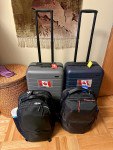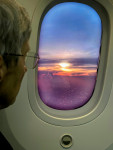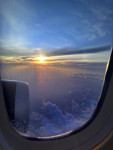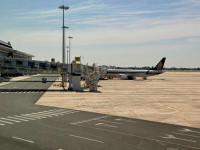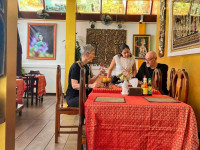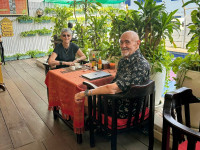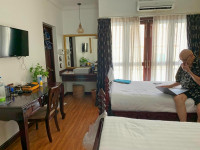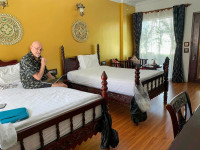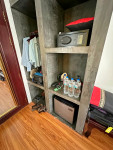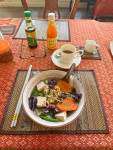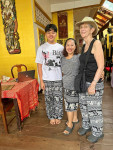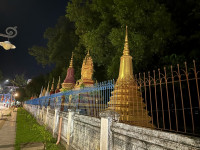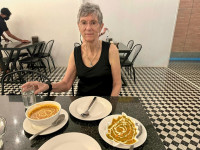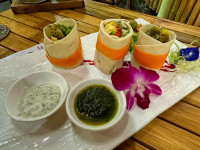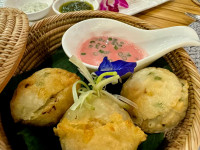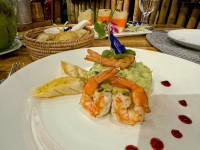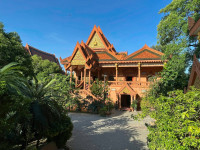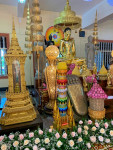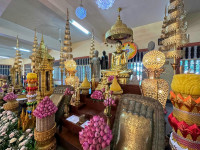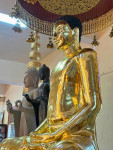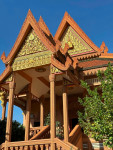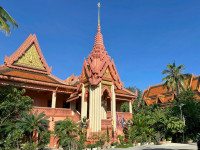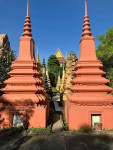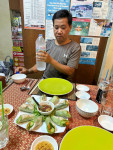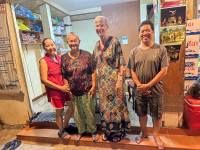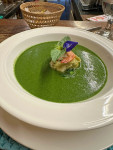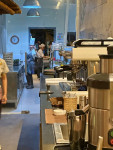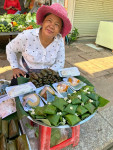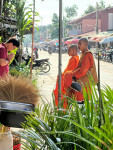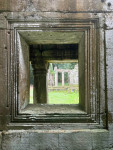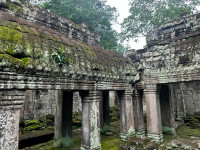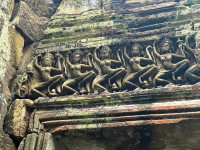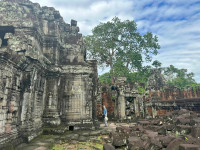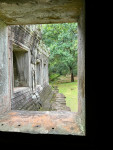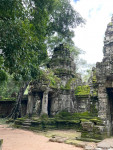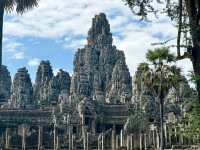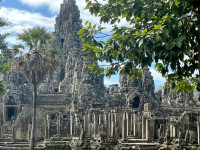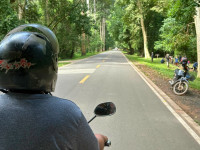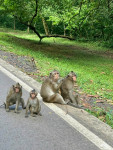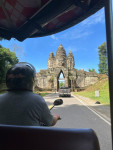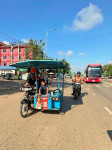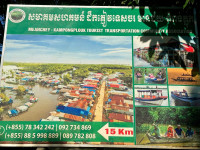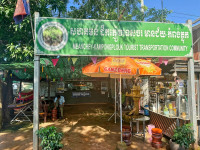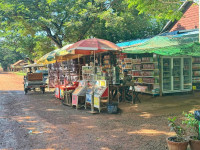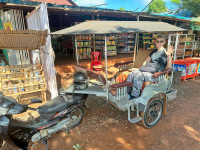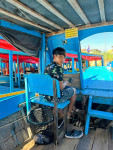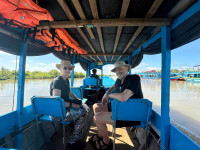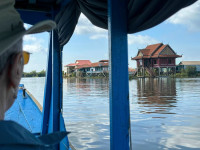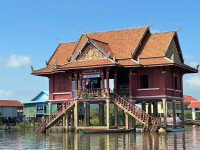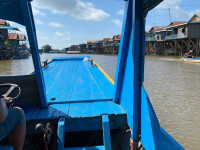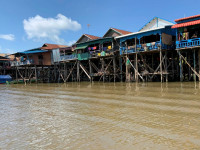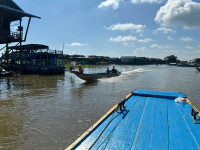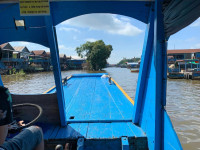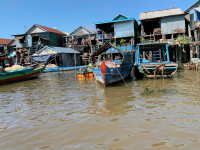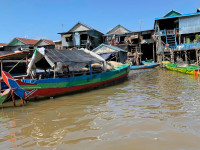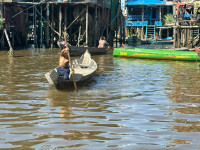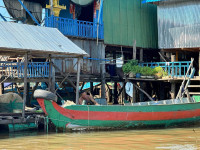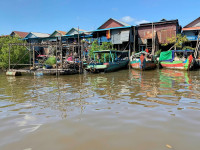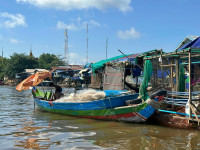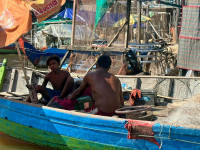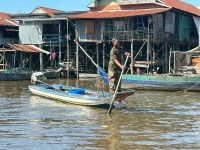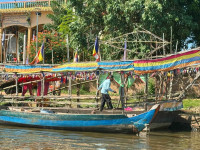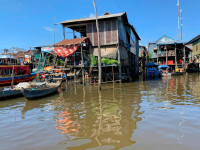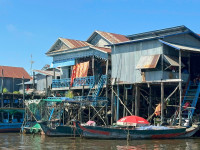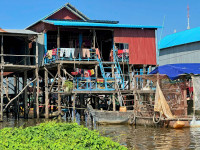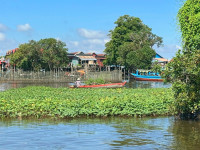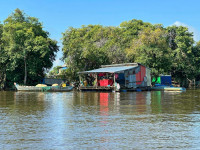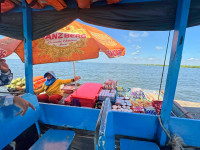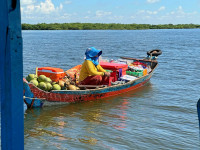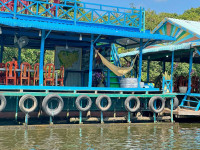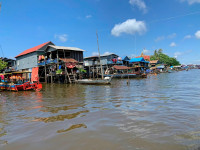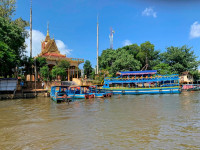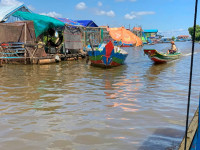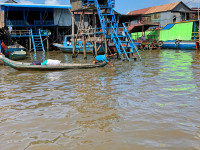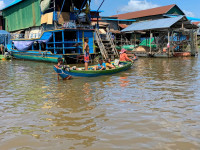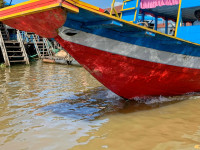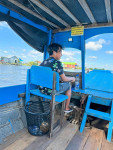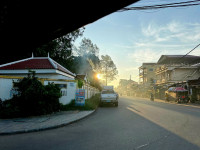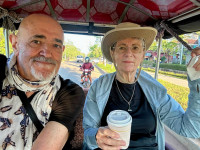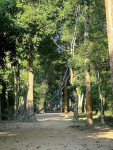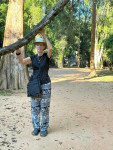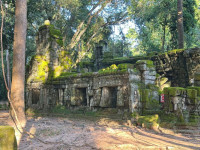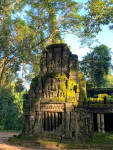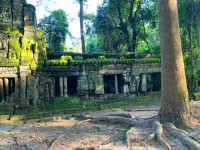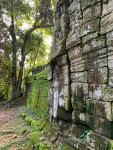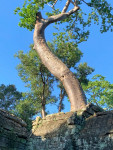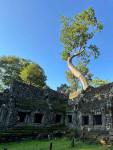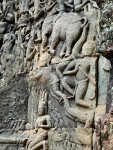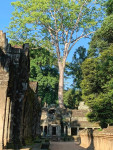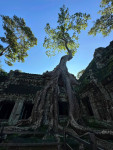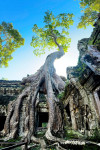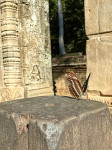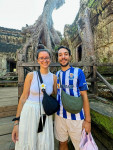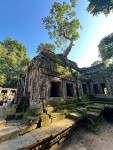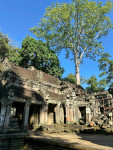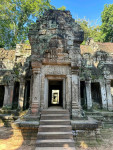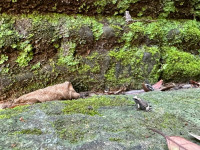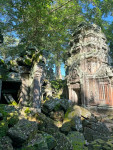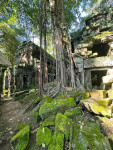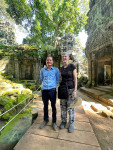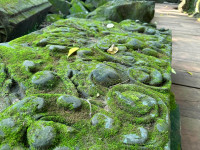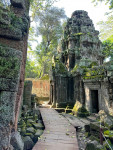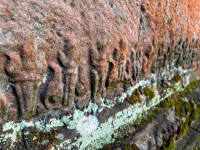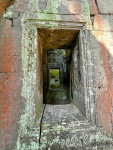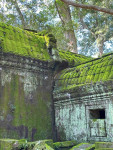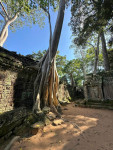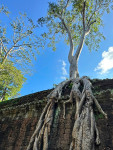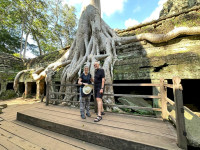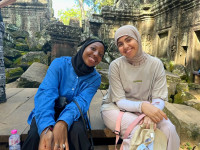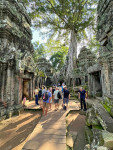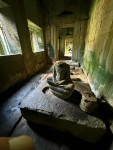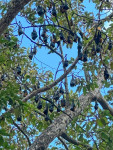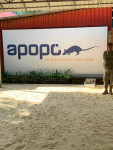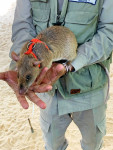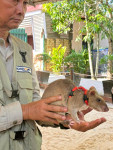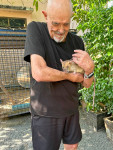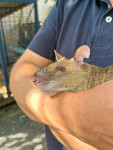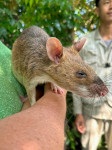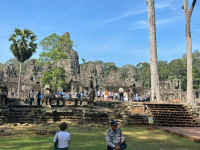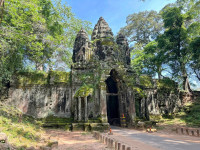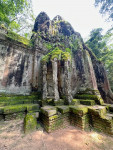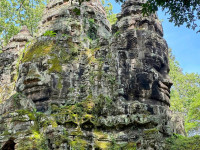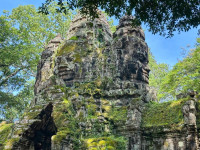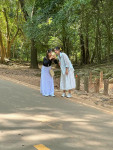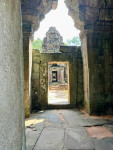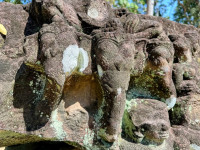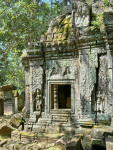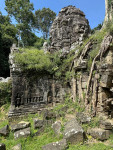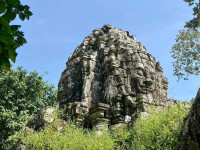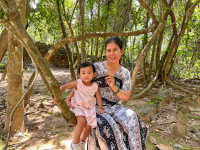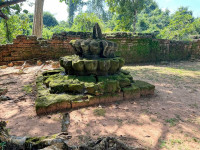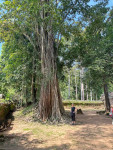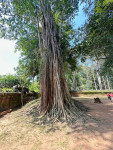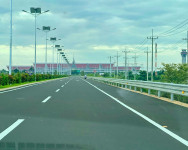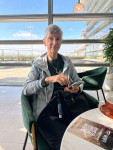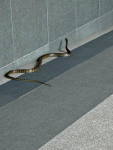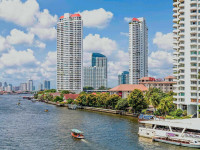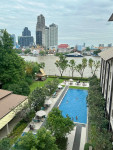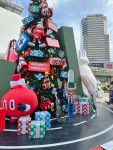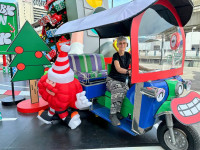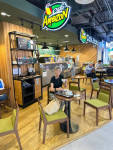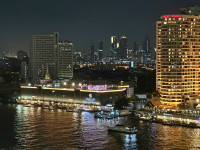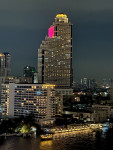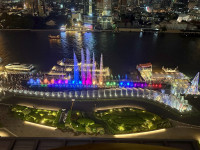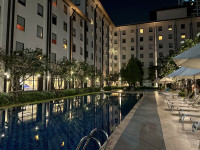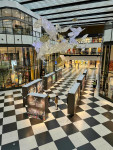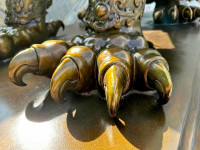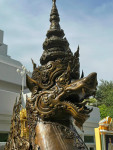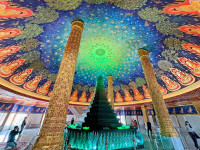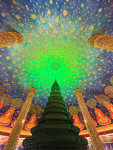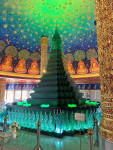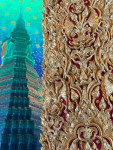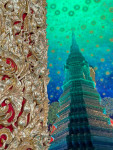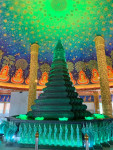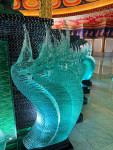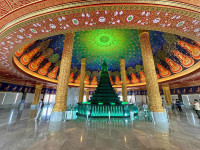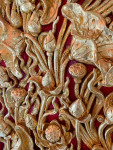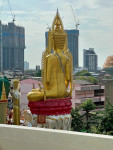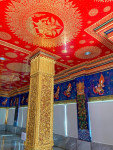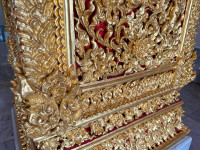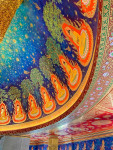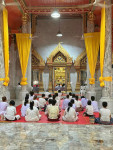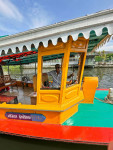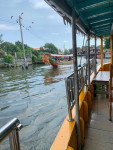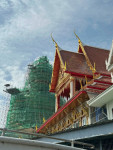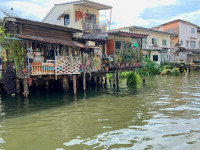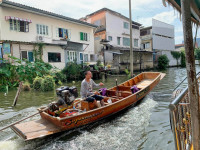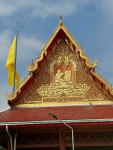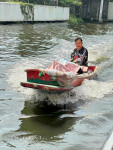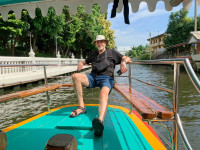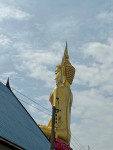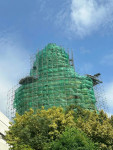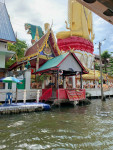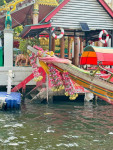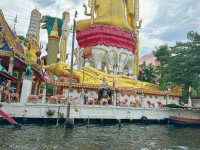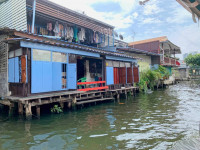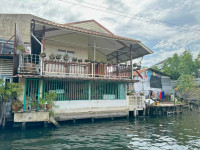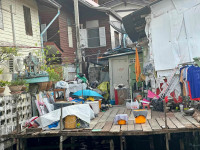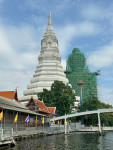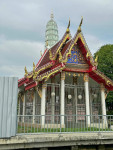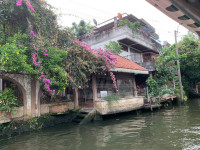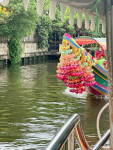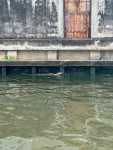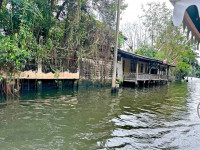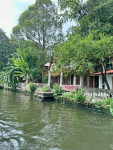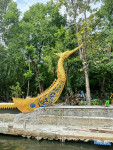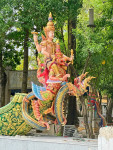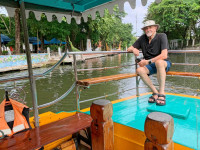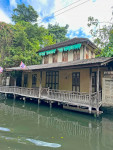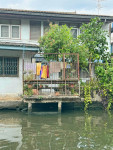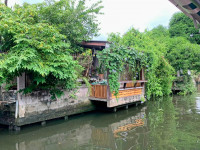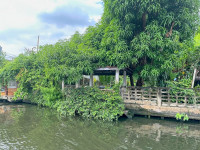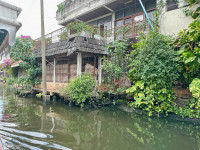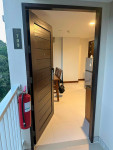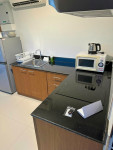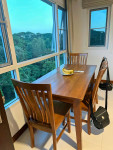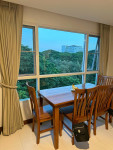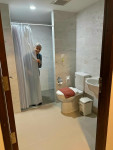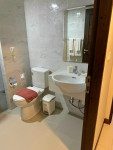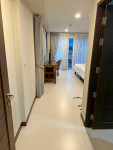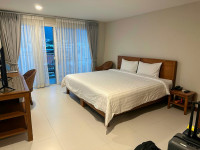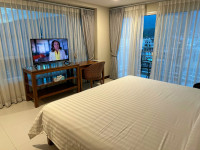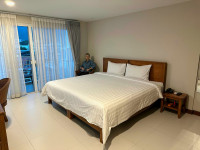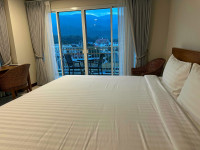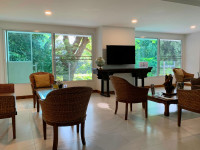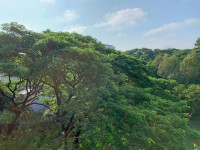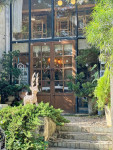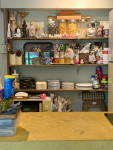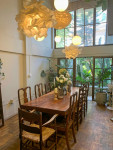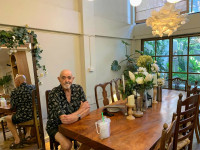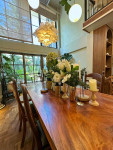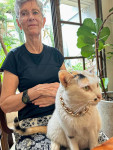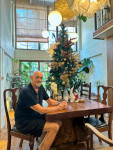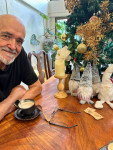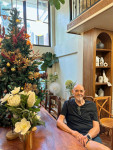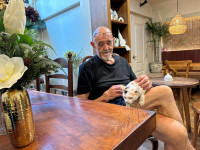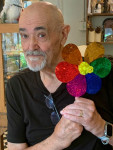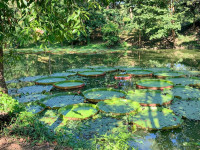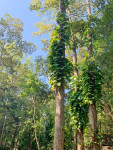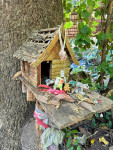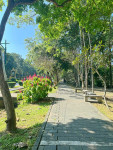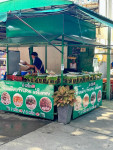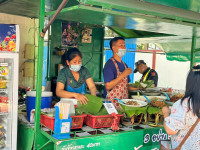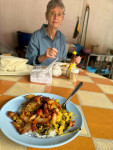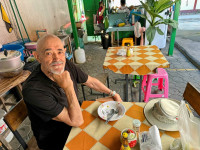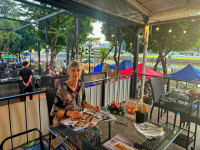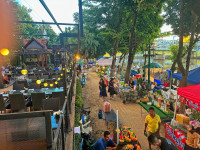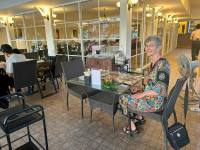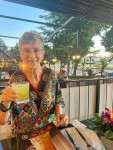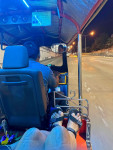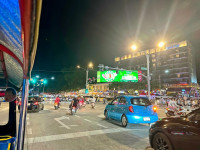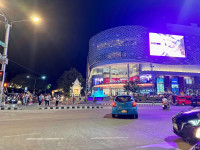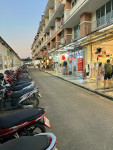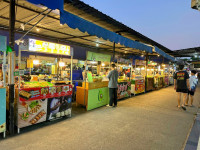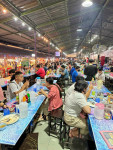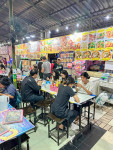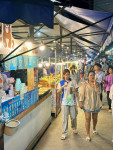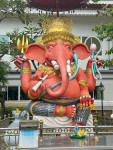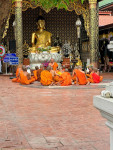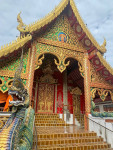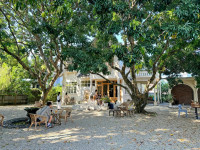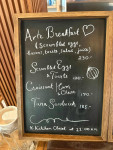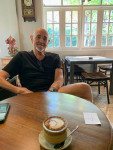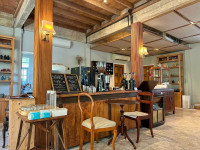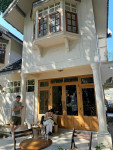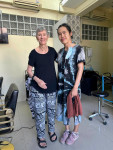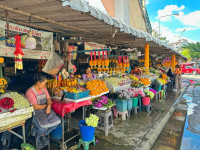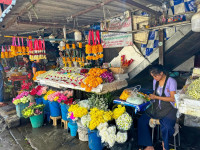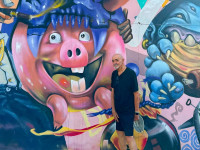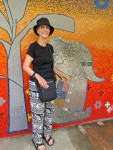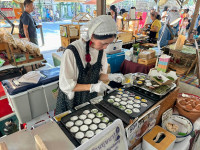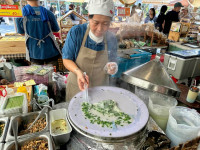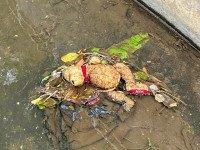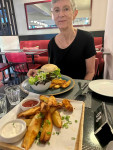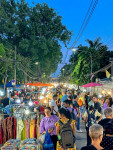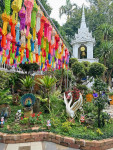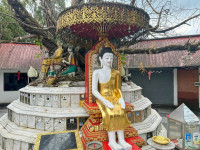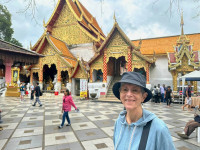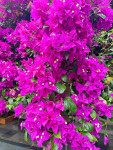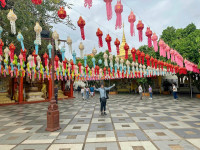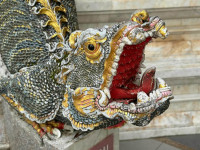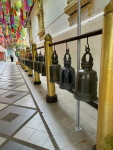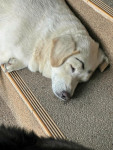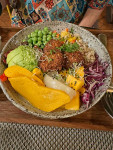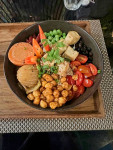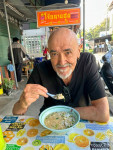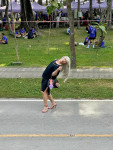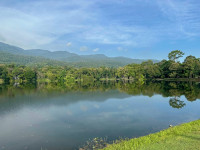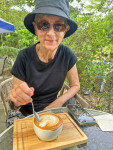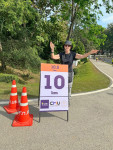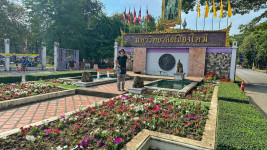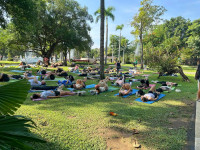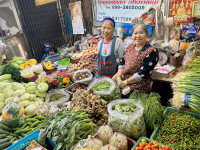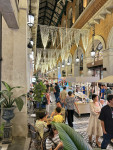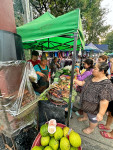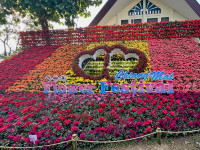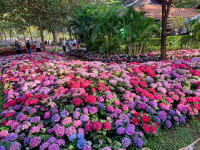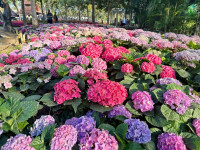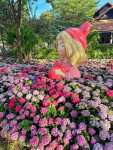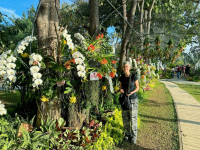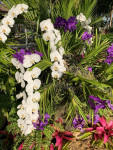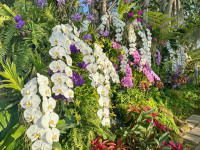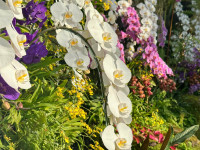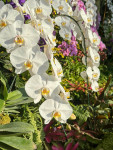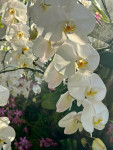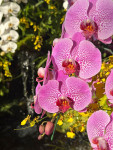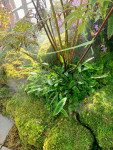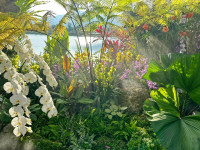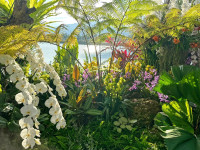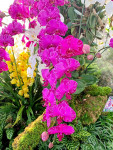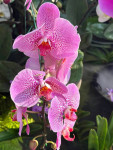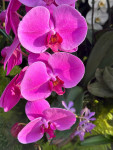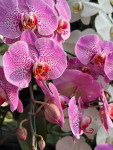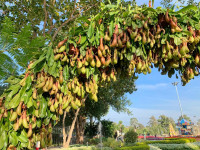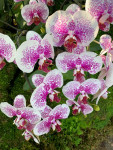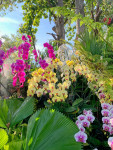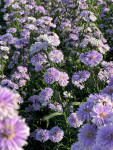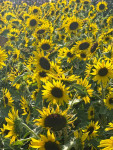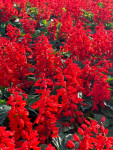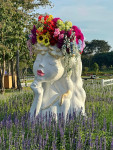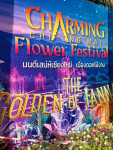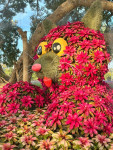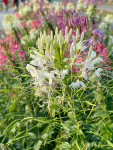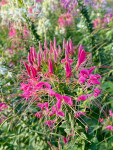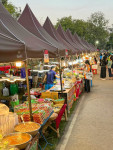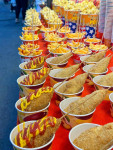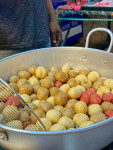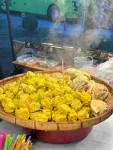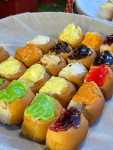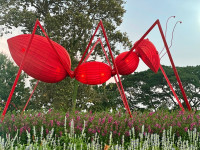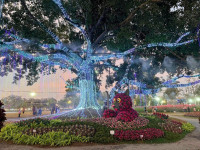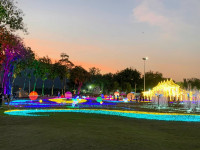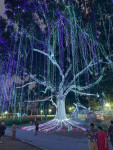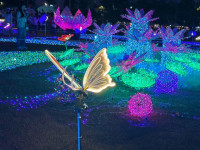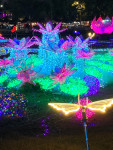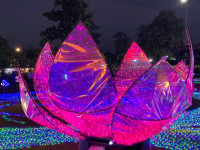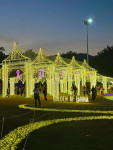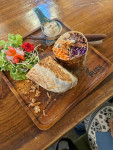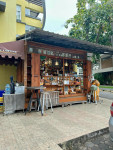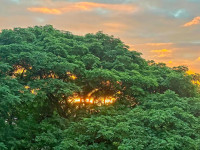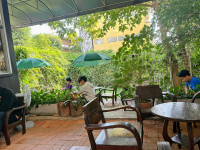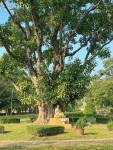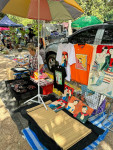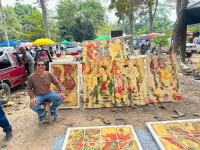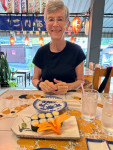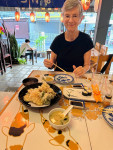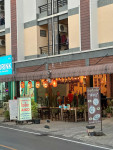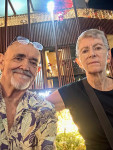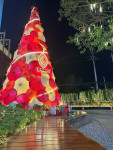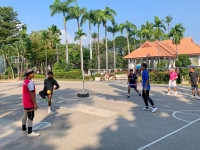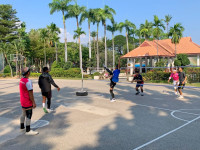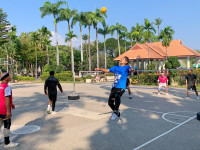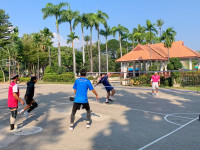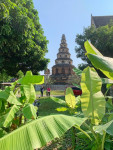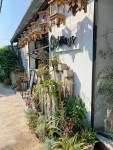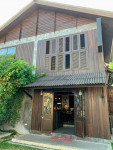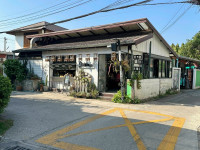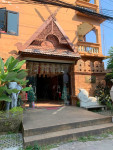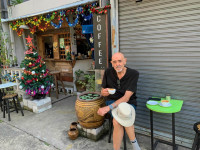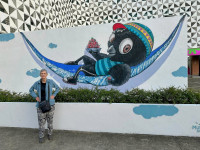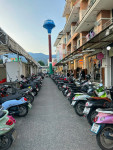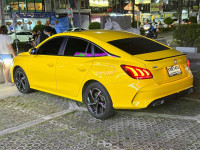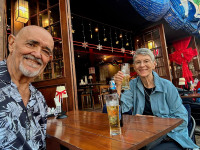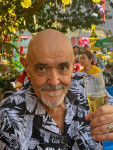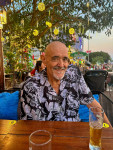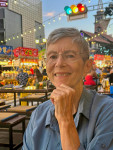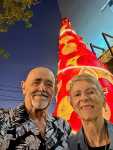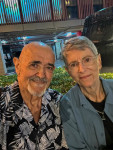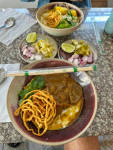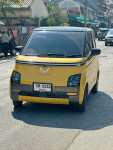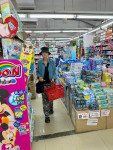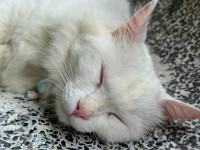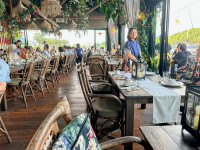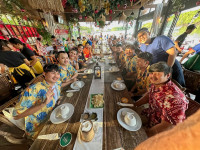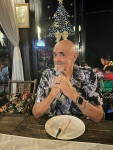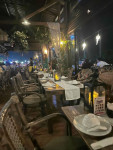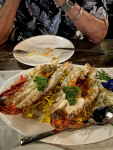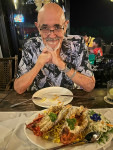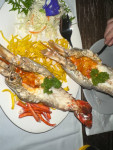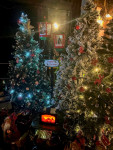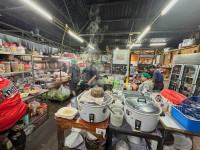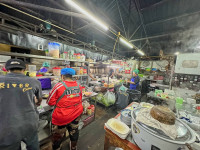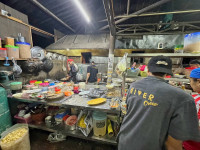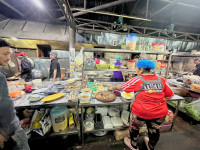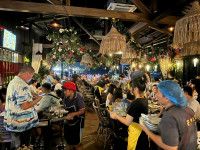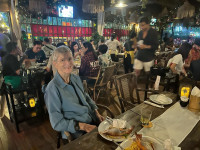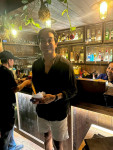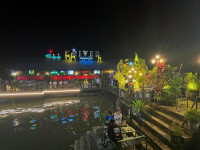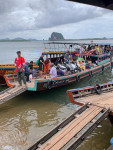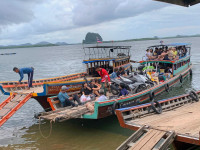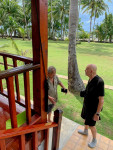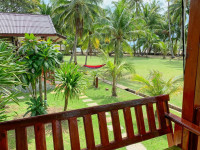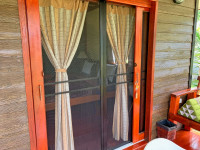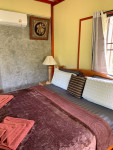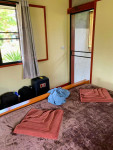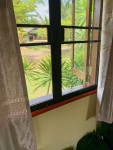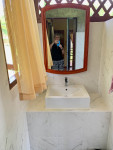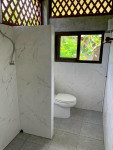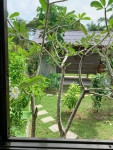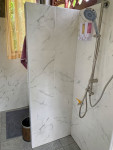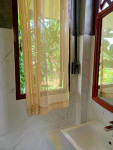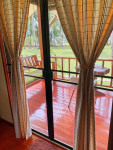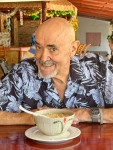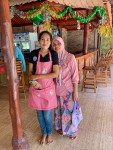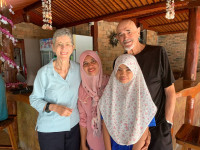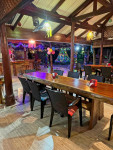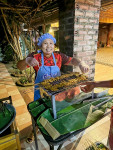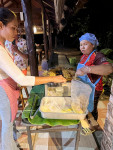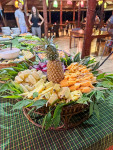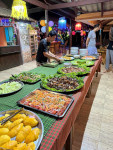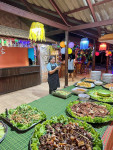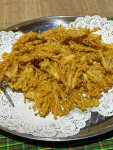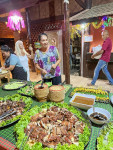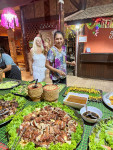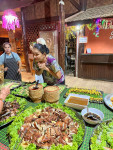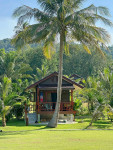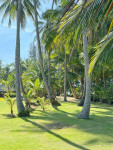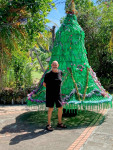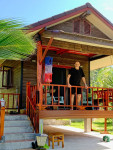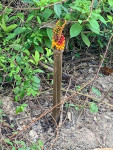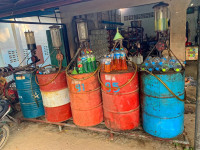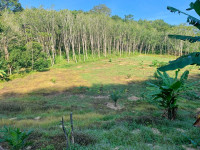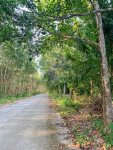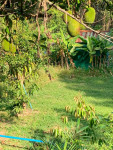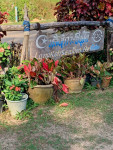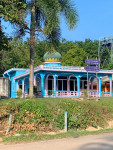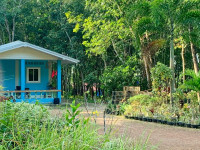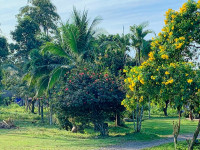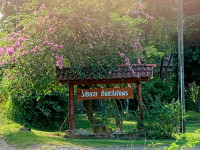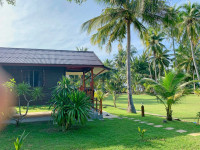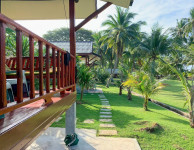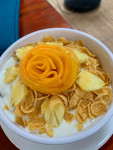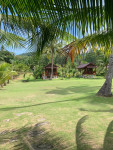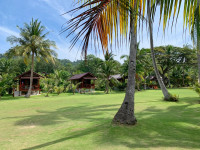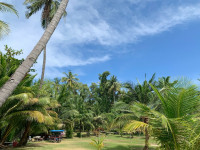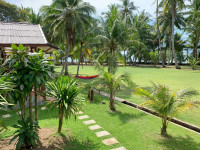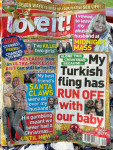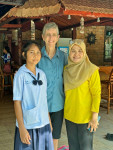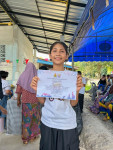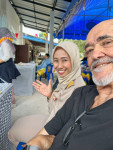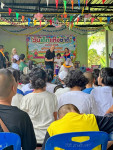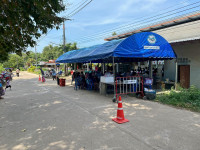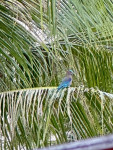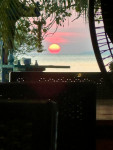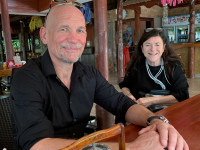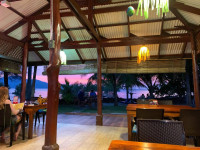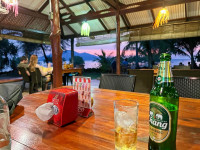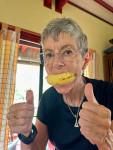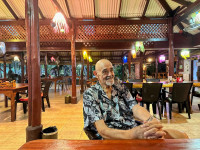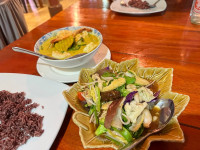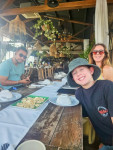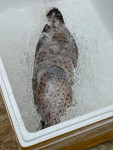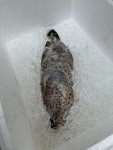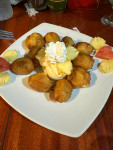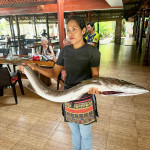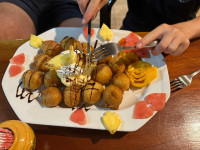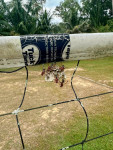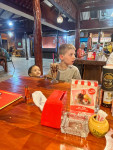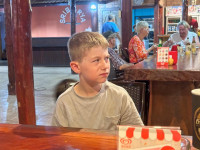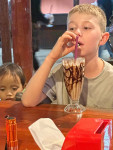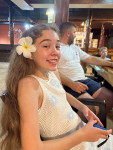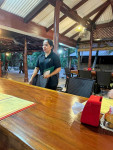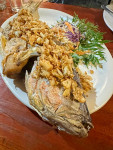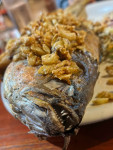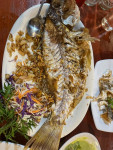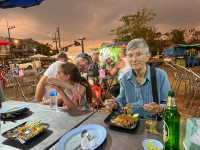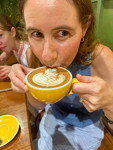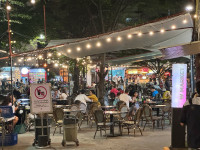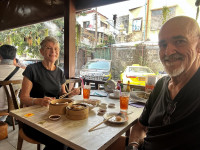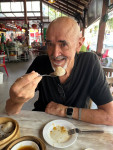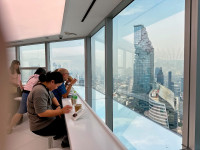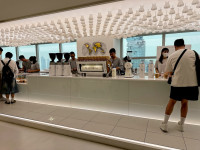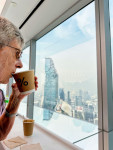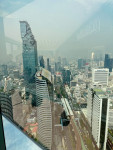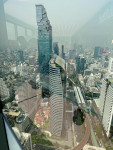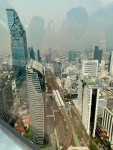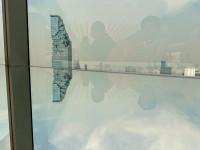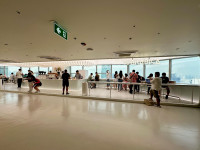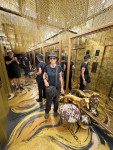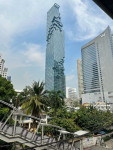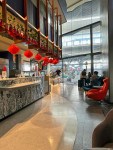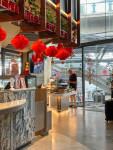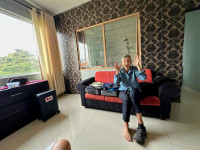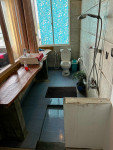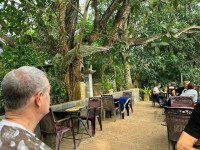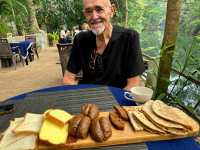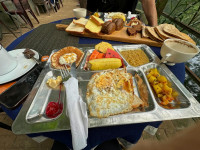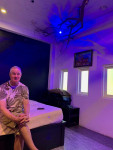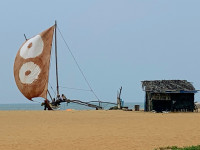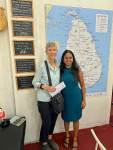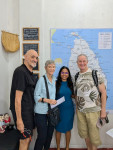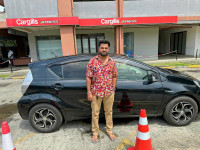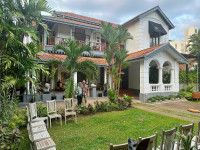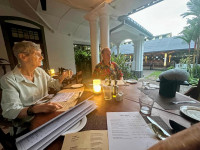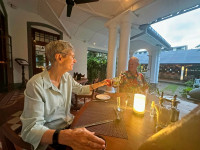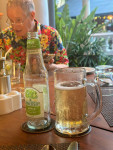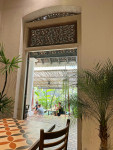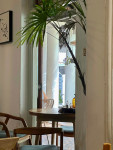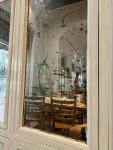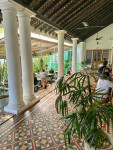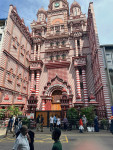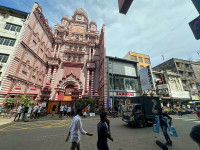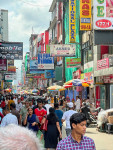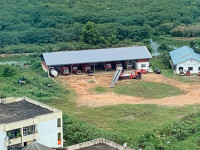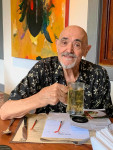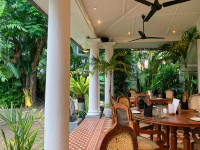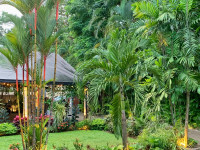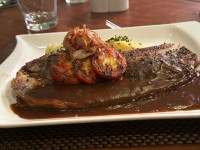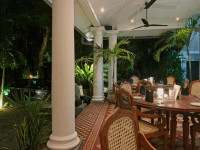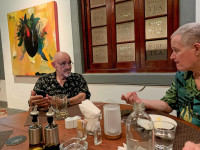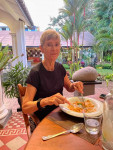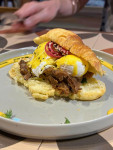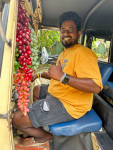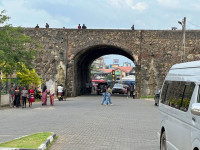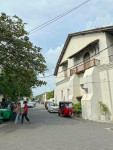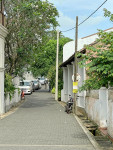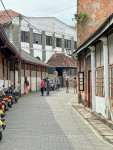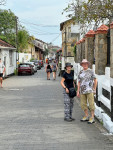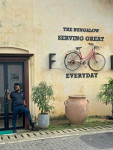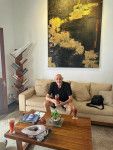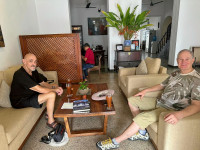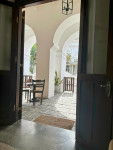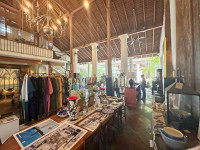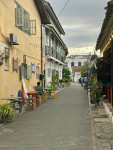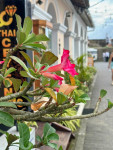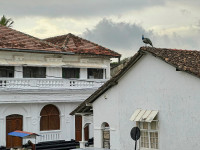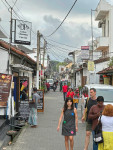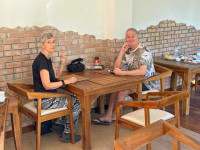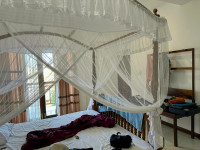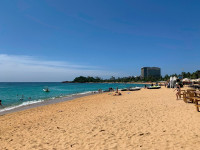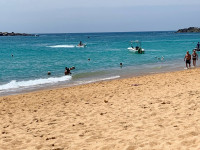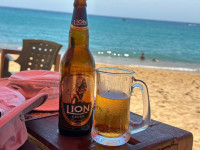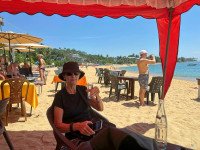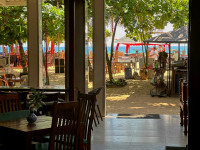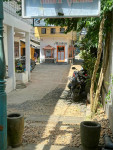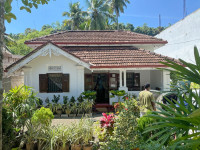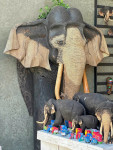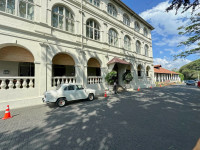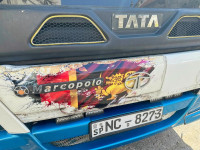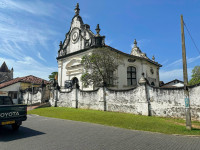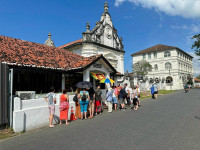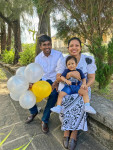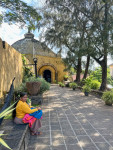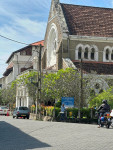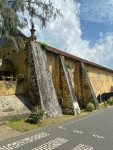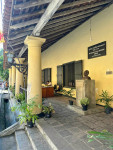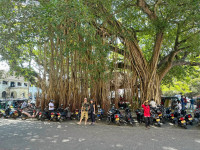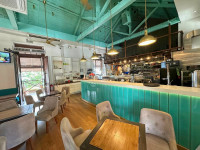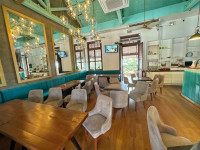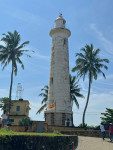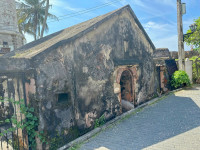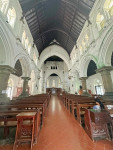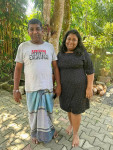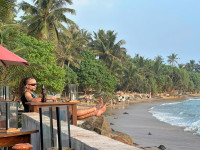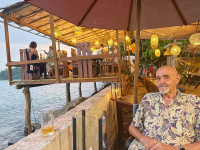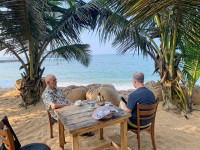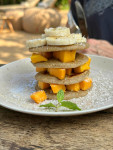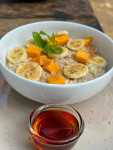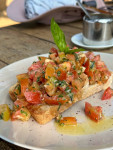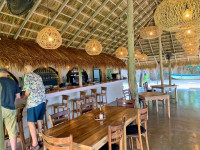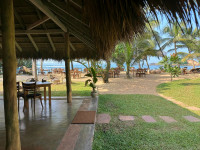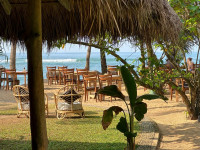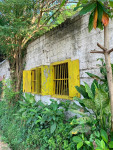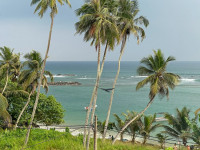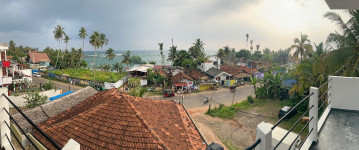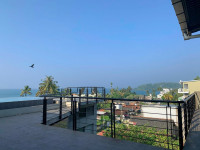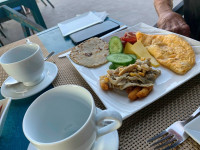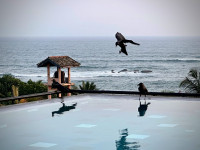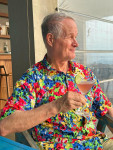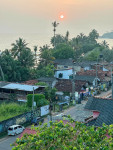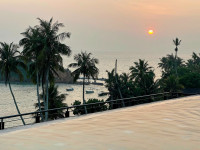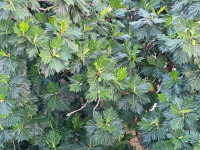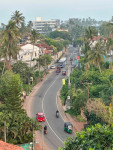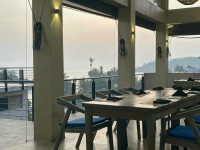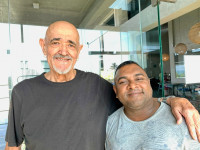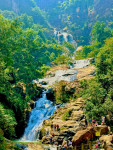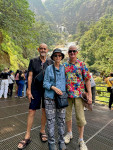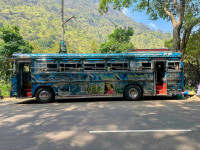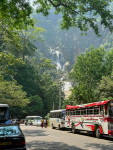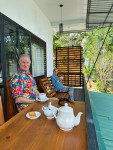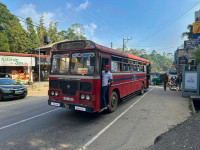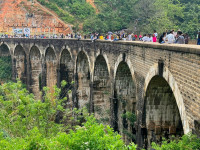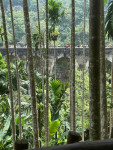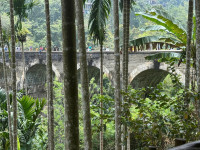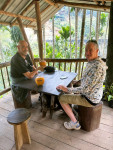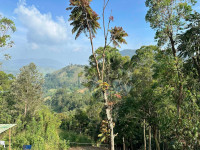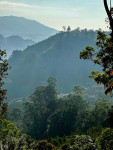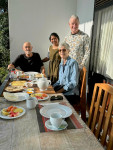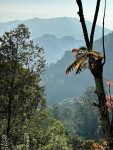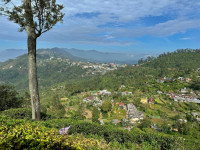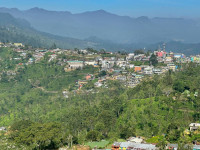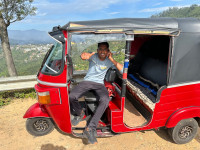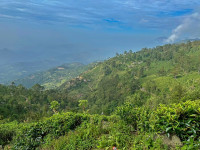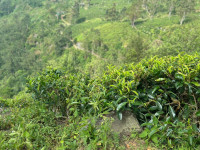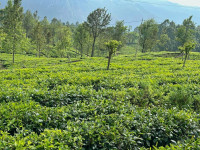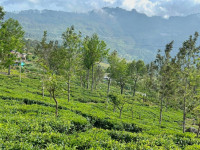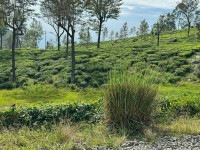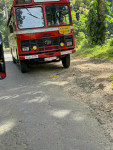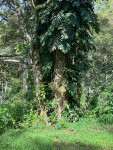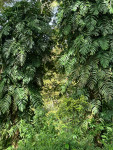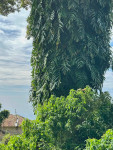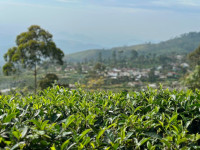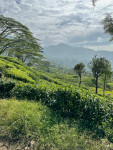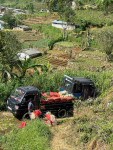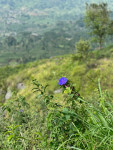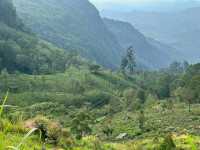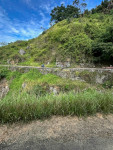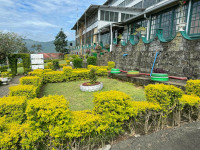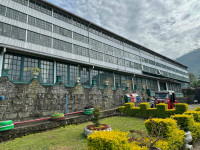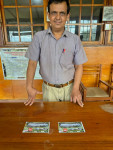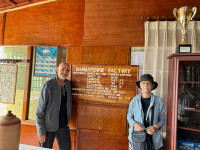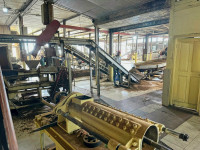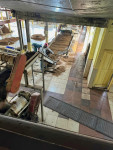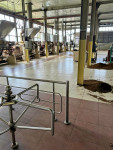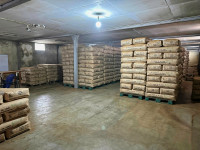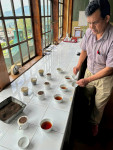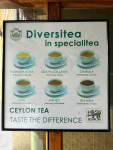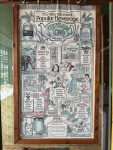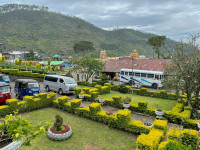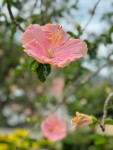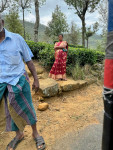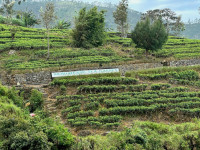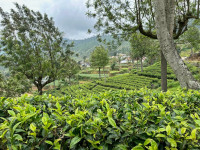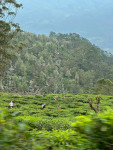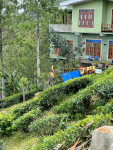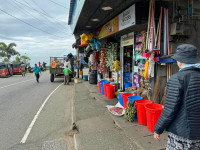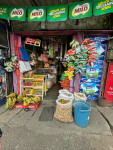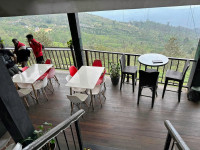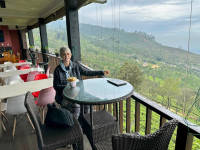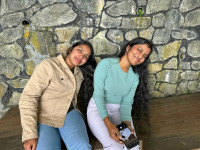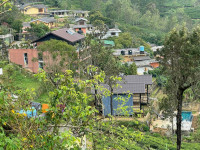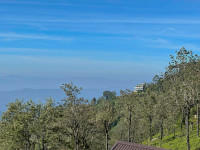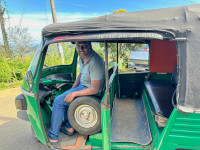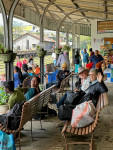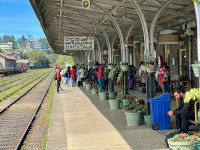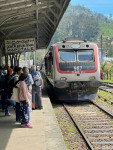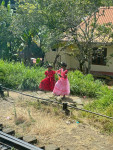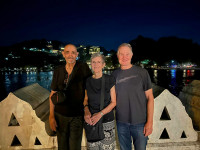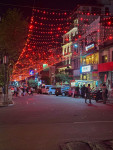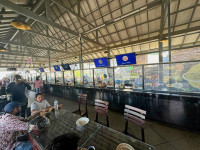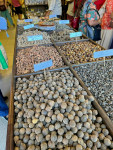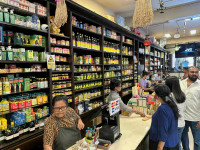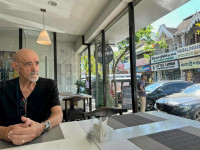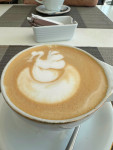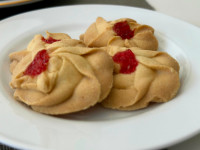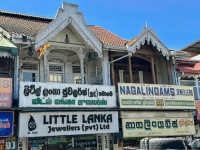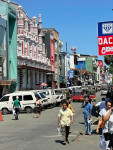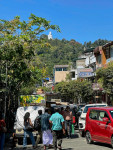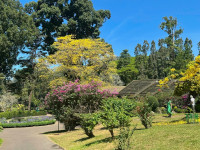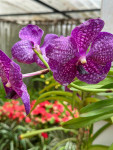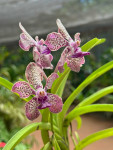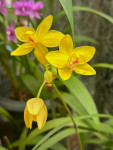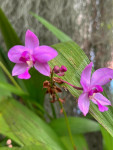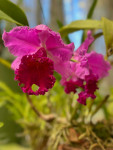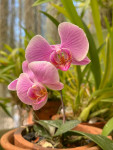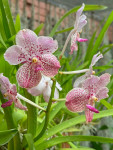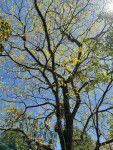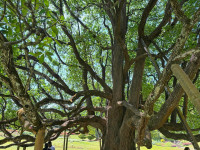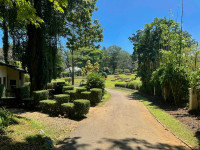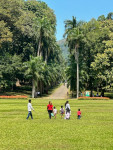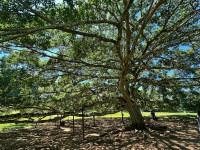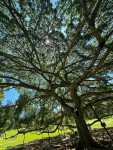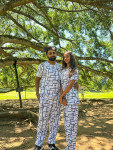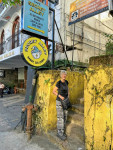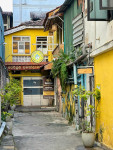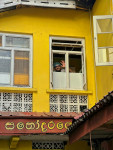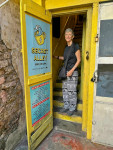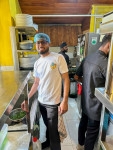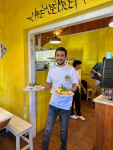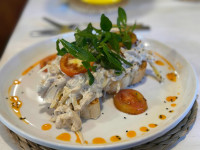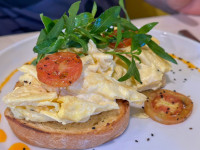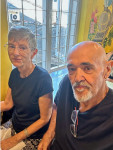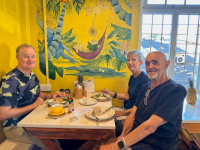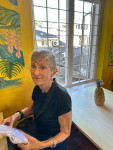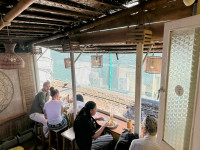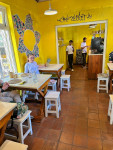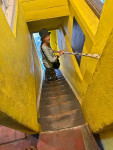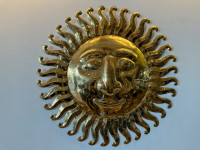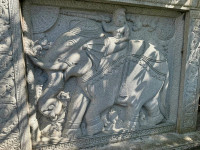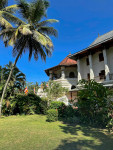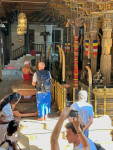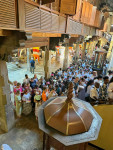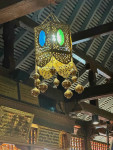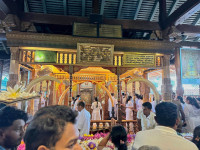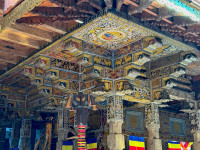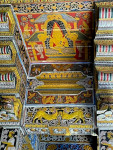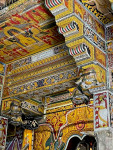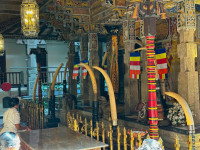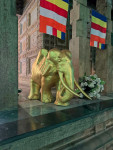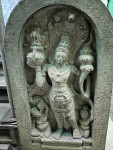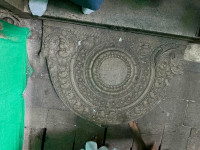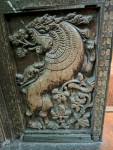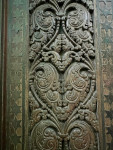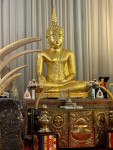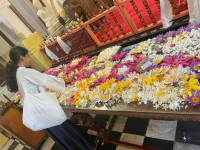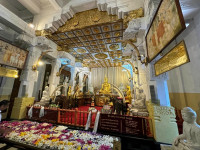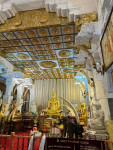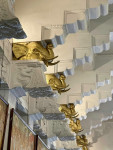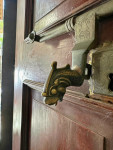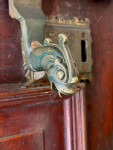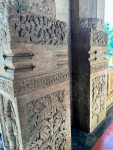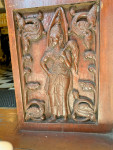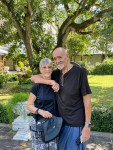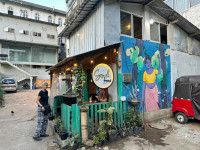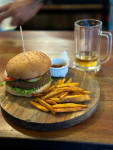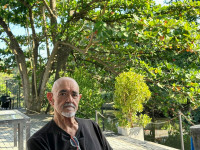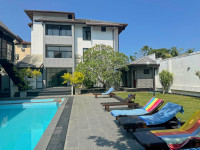October 2024 – February 2025
Cambodia – Thailand – Sri Lanka
- Oct22 – ✈️ Victoria > Vancouver > Singapore > Siem Reap, Cambodia
- Nov04 – ✈️ Siem Reap > Bangkok
- Nov11 – ✈️ Bangkok > Chiang Mai
- Dec27 – ✈️ Chiang Mai > Krabi
- Dec29 – 🚕 Krabi > Siboya
- Jan20 – 🚕 Siboya > Krabi
- Jan21 – ✈️ Krabi > Bangkok
- Jan28 – ✈️ Bangkok > Negombo, Sri Lanka
- Jan30 – 🚕 Colombo
- Feb01 – 🚕 Galle
- Feb04 – 🚕 Mirissa
- Feb08 – 🚕 Ella
- Feb10 – 🚕 Haputale
- Feb12 – 🚂 Kandy
- Feb15 – 🚕 Negombo
- Feb18 – ✈️ Colombo > Bangkok > Vancouver > Victoria
2024-10-22
Victoria ✈️ Vancouver ✈️ Singapore ✈️ Siem Reap
It seemed a little weird this year heading off from home at 5:00pm. Can’t remember any of our trips to Asia that didn’t start at the crack of dawn. Not looking forward to yet another epic trek. This one is a long 31 hours from our door to our hotel in Siem Reap.
Yes it was another long flight, ✈️ exhausted, but very happy to see Kat (our always tuk-tuk driver) and his perpetual smiling face waiting for us at the Airport Bus Terminal to whisk us off to Beyond Yangon Inn where we were warmly greeted with ice lemon tea and dragon fruit by his sister Sokunthea. We met Sokunthea and husband Maung Maung way back in 2003 when they had the Mandalay Inn Guest House. Fast forward, they have continued their success, bought land and built a boutique hotel with 10 rooms, all decorated in a luxurious Burmese motif (Maung Maung was born in Burma/Myanmar) complete with swimming pool.
Once we recover from jet-lag, the routine for the next 10 days will be breakfast poolside, explore new parts of Siem Reap, the amazing Angkor Complex, nap at 2pm and plan for where to go for dinner. So many superb food choices, although we ofter end up just around the corner at SPOONS Café Restaurant
Tuesday we’ll start touring our favourite temples with Kat.
2024-10-28
Siem Reap, Getting acclimatized takes a few days. 🥵
It’s been a 4 days now since we arrived in Siem Reap after an exhausting 31 hours door to door. We have definitely been dragging our asses for the first 2 or 3 days, acclimatizing. For us that means basically hanging around the hotel, eating, short walks and sleeping. We did make a point of morning walks while it was cool though. It’s only just the beginning of tourist season, but Siem Reap is still struggling to get back on it’s feet after Covid.
The restaurant scene continues to churn, with many closures and new hopeful ventures everywhere. Our down time research during the spring and summer back home is reaping it’s benefits, and with more new development on the east side (our side) of the river to explore. Siem Reap is definitely growing up and continuing to gentrify.
2024-10-29
Siem Reap, First venture out to the Angkor Complex
Some of our days go like this: Kat collects us at 7:00 and we grab a cappuccino enroute to the Angkor complex. Riding in a tuk-tuk in the early morning is truly magical. All the locals are bustling around with morning duties, hopeful they will have a profitable day serving the tourists. The many narrow roads weave throughout forests of Angkor… more than 400 acres. Everything is still very green and lush as the rainy season has only just finished. The seasonal mossy hue covering many aspects of the temples is electric. It stretches the imagination when you realize that 1200 years ago, this was a city of almost 1,000,000 people. Bye comparison, London at that time had a population of only 80,000. Staggering.
Our first venture out to Angkor, was to visit the Preah Khan temple, built in 1191, the temple is still largely unrestored: the initial clearing was from 1927 to 1932. Since then free-standing statues have been removed for safe-keeping, and there has been further consolidation and restoration work. Throughout, the conservators have attempted to balance restoration and maintenance of the wild condition in which the temple was discovered. It’s beautiful. It’s a favourite that is missed by most, so we usually get to explore all alone in the silence, magically punctuated by flocks of raucous parrots screeching at each other. 🦜
2024-10-31
Siem Reap, New adventure out to Tonle Sap Lake
In past years we have loved hopping in Kat’s tuk-tuk and just heading out into the country side. Invariably we would meander the back roads and end up at the Phnom Krom causeway which is the gateway to Tonle Sap Lake. There used to be a boat that went from here all the way down to Phnom Penh. It seems to be paused since Covid.
Tonle Sap Lake is the largest lake in all of SEAsia. Having said that, it’s area is an interesting, moving target. At it’s minimum, it is 2,700 km2 and at it’s maximum it is 16,000 km2. This expansion happens every year to varying degrees depending on the intenseness of the monsoon rainy season in addition to seasonal typhoons. It expands as the flow of the Mekong increases to the point that when it finally overwhelms the downstream capacity of the Mekong Delta in Vietnam. This unique seasonal reversal is amazing on scope. Read all about it. ( Link )
This year we ventured to the Tonle Sap village, Kampong Phluk. The community largely depends on fishing for survival, primarily shrimp during the wet season. Most houses and buildings are constructed on stilts ranging from 6 to 9 meters to accommodate the changes in water level between wet and dry seasons. Imagine having to climb a 9 meter ladder during the dry just to get into your house.
Our 2 hour boat tour (down and back), took us 2-3 km down to the lake, passing through village life going on all around. Out on the lake we were met by the ubiquitous sampan, a lady selling snacks. We contributed with the purchase of a delicious green coconut. Yum 🤤
During the dry season (November–April) the river thins due to receding water, many turn to farming to supplement their income. Tourism, which started in the village approximately 10 years ago, is also a growing part of the local economy. As of 2019, the commune has 900+ families with a total population of 3000+.
2024-11-01
Siem Reap, Visiting old haunts, Ta Prohm Temple
Off we go, morning cappuccino in hand, to a favourite temple. Ta Prohm is easy to navigate and super photogenic. Unlike most Angkorian temples, it has been left in much the same condition in which it was found. The atmospheric combination of trees growing out of the ruins and the jungle surroundings have made it one of Angkor’s most popular temples with visitors.
This morning we were almost alone. Ta Prohm is also covered in electric green moss still hanging on from the rainy season. We have already taken Soooo many photos of these ruins, but just can’t resist a few more. Enjoying the photographic ability of the iPhone 14 Pro Max. I remember the days when we used to travel with rolls of Kodachrome 100 and every shot was very valuable and calculated. 🎞️
By the time we were done, the tour groups had descended on Ta Prohm with megaphones and flags to herd the masses. Our 2 hours here was great, now it’s back to town for breakfast. A short stop in the centre of town at the Royal Independence Gardens to see the giant fruit bats (Flying Foxes, these ones have a wing span of about 80cm). They don’t sleep where they eat. They prefer to fly the distance to munch on fresh fruit and then fly the same distance back to spend the day sleeping atop the trees of downtown Siem Reap.
Time for noodle, vegetable soup, a shower and some chill time in the A/C.
2024-11-02
Siem Reap, Visiting APOPO and Ta Som Temple
Today is our last chance to go out for the day with Kat. Tomorrow he has a previously booked client and we fly to Bangkok the day after. So today, we’re going to indulge in a “Tourist” venue: APOPO The name is from the Dutch, Anti-Persoonsmijnen OntmijnendeProduct Ontwikkeling. Anti-Personnel Landmines Detection Product Development
The short story is: back in 1997’ish an Belgian man was reading about gerbils 🐹 being used for land mine detection. He had pet rats 🐀 and thought they would be more appropriate. Fast forward, he got a grant in Belgium for a study and today we have APOPO. They are lighter than sniffer dogs, so less risk of accidental detonation. They can clear an area in 1 day that would normally take 4 weeks.
We went early and luckily got into a group with just 1 other couple. A quick briefing and a demo with the handlers and then a touchy feely, hold the rats bit. Quite large and very docile. It was a very well done, very informative presentation. 👍
Now we’re off to Ta Som Temple, a small, usually quite, out of the way site. It’s so interesting that they are so similar but on such different scales. A quick wander around, more stunning photos, then back to town. We treated Kat to avocado, poached egg, toast. It’s always a little weird taking Kat out for a meal. Breakfast for the 3 of us was CA$25, as it was an upscale western joint. Kat’s daily rate for a Full Day is US$25. But, he is worldly enough to get it, and be very gracious.
After, Kat dropped us back at the hotel and we said our goodbyes till we meet again. And as we age, the next time get increasingly nebulous.
2024-11-04
Flying Siem Reap to Bangkok
Our time in Siem Reap has come to an end. 10 days just seemed to zoom by. Had a great time, and now we are off to Bangkok for 5 nights.
The new airport at Siem Reap was constructed 60km from town, which means tuk-tuks are not so feasible as transport choices. That’s a big hit for small time drivers income. Chinese money built the new facility and they have the contract to operate it for 30 years. Very Chinese architecture. Huge and with very big taxes and fees. So much so that many airlines have paused coming. We’ll see.
A short 45 minutes to Bangkok, sky-train to downtown and then Grab (Uber in Asia) to our riverside hotel. First order of business is to get SIM cards for Thailand. Can’t order Grab till we have a phone number. 7-11 has a great deal, unlimited data and Thai phone calls for 30 days – THB 350 (CA$14). As usual there is a 7-11 everywhere, so short walk from our station. As we sat in a small plaza, SIM’ing up our phones, a security person approached to say we could not sit there and we should move inside the building. As I questioned the logic of that while in the middle of phone mechanics, out of the corner of my eye I caught movement. I turned to face 3 meters away, a 2m long snake was rapidly trying to gain purchase on the slippery granite. We quickly relocated. Have never encountered a snake in downtown Bangkok in 45 years. 😱
Welcome to Bangkok, excitement over, we hailed our Grab and headed for The Ibis Riverside Bangkok. 😎
2024-11-05
Bangkok, down by the river.
The Ibis Riverside Bangkok. Absolutely fabulous location right on the river, very nice pool and breakfast included, a great deal at CA$98/night. 😎
After staying for a month in Bangkok last year we are enjoying being back in the Bangkok, Blade Runner vibe. The food choice are so very varied. (did I just say that?)
We stayed on the west side of the river for most of our time, but did venture over to MBK, the huge Thai style mall downtown. Also revisited New Road to stop in at SiamBronzeFactory to buy a replacement dinner fork.
Caught the spectacular ICONSiam Water Light Show form the 7th floor balcony. Wow this city is on such another level. 🤯🎆. The river view at night is like no other. Bangkok is back, scads of dinner cruise boats jockeying to dodge the tugs with their barge trains, not to mention the speeding long-tail boats zooming around.
2024-11-08
Bangkok, Wat Paknam Phasi Charoen
This is first time we’ve stayed on the west side of the Chao Phraya River in Bangkok. We’re finding it much more local that downtown notwithstanding the areas around hotels and malls. We’re lucky to have several local restaurants right at the end of the access lane entrance to our hotel. A short walk to many dinner choices.
Today’s adventure is to Wat Paknam Phasi Charoen which house the largest Buddha Statue in Bangkok, the image is 69 meters (226 ft) tall. The image is made in meditation posture. The material the image is made of is pure bronze, making the image the first of its kind in the world. The temple’s grounds are shaped like an island, surrounded by canals.
Unfortunately, the Buddha was shrouded in scaffolding getting some last minute remediation. But we did get to enjoy the stupa named “Maharatchamongkhon”. The 80 meters (260 ft) high stupa has a twelve-sided polygon shape with five floors in it, including another 8-meter glass stupa. The stupa was finished in 2012, costing a total of 500 million baht. The dome ceiling at the top floor is spectacular.
Even thought the Buddha statue was shrouded, we hopped in a small boat to do a half hour cruise around the complex and get a feel for everyday life the people have who live here. Fun.
2024-11-24
Bangkok to Chiang Mai – Nivas Serviced Apartments Hotel
It’s a travel day today, Bangkok to Chiang Mai. No issues, but it does seem to take all day. Taxis to the airport can take 2 hours navigating the sometimes horrendous Bangkok traffic. We opted to get to BKK early and do our waiting in a lounge rather than late checkout at the hotel. The flight was an uneventful 1 hour, then a 15 minute taxi to our new digs.
The Nivas Hotel Chiang Mai was a Joann find. We had already booked an Airbnb when she happened upon this place. The attraction was… a different location in town, it’s a serviced apartment and it has a way better price point. Even thought the published daily rate is CA$127/N, the monthly rate breaks down to CA$35/N. 😎 Book it Danno!
Real life did not disappoint. Our research had lead us to picking the 7th floor Deluxe Corner Suite. Correct choice. Windows on 3 sides, morning view at the kitchen table is sunrise over a 27 acre forested Jesuit Retreat, the south side overlooks the pool and west side is the balcony off the bed-sitting room looks at Doi Suthep, the 1,676 metres (5,499 ft) mountain that house the famous temple at the summit . Evening sunsets are sweet. And… it’s the first thing you see in the morning from bed.
Extremely well run, terrific staff, fastidiously clean, nice solid substantial furniture and a new local neighbourhood to explore. We’re so happy that we’ve even booked 2 months for next year, 2025-2026. 🎉
2024-11-09
Chiang Mai – Pine Café
We’ve been here 2 weeks now. Really enjoying the new locale near CMU (Chiang Mai University). During our research (Google street viewing) around the neighbourhood, we saw a hole in the wall coffee shop… the Pine Cafe. It’s a 3 story townhouse where the first 2 floors house a boutique artisan coffee shop. What a gem. Kinda cute and unexpected from the outside, but a delightful peaceful enclave within.
Just inside the front door are an auto-food-water station and an automated kitty litter appliance for the resident 5 cats. They are delightful, but a quite aloof/bored with the attention.
Past the front service area opens into a high ceiling room with stairs to the mezzanine with more tables. This room is such a chill place to have a relaxing cappuccino. And we do, often.
2024-11-28
Chiang Mai – Bits and Pieces
Luck for us (actually it wasn’t luck, it was one of the deciding factors for choosing the Nivas Hotel) and just a 7 minute walk is a huge open air food court with 20 or 30 restaurant options serving very good Thai food and other Asian styles (Japanese, Korean and some pseudo western). Also many stalls featuring take-away snacks on sticks, always a local favourite especially with students. Yes this huge every evening food extravaganza is just across from the entrance to CMU (Chiang Mai University). 27,000 student have to eat somewhere; and you know that means, cost effective, top quality and tasty as hell. If it was otherwise they wouldn’t last. We agree and dine here frequently.
Also in our neighbourhood just past the Pine Café is a local business area with morning soup joints, fresh food stalls, and various shops, a 7-11, and the Nana Bakery. Yay, the Nana is a wonderful hole in the wall bakery, serving croissants of all sorts and artisan breads. Loving their sourdough rye.
We’re trying to get out in the cool mornings and explore various neighbourhoods. Take a ride hail to a specific city location we haven’t been to and walk around looking for a new breakfast experience.
Saturday we went to the Jing Jai weekend market. Caters to more upscale Thais or Asian tourists with “cute” clothes and nick-nacks. Lot’s of street/finger food stalls and artisan coffee baristas and multiple seating areas with live mellow music.
The Sunday Evening Walking Street was way to crowded. We only lasted one block before making our escape. The next morning we went up to the Wat Phra That Temple at the top of Doi Suthep (Mount Suthep). Haven’t been up the top for many years and have actually never been to the very famous Temple. So, check that off.
2024-12-20
Chiang Mai – Bits and Pieces (Part 2)
Well it seems like our time here in Chiang Mai has gone far too soon. In one week we head south to Krabi. I think there is something to the old adage that time goes quicker as we age. We spent so much time researching and planning last spring for our 7 weeks here. Pooof. 💨
Life has been blissful and we’ve fallen into an easy going schedule. Starts with coffee, then out for a 2km’ish walk. We are just a short walk to the Chiang Mai University campus (38,000+ students), where there are 725+ acres of park land with scattered Faculty buildings and numerous artisan coffee shops for a cappuccino. Then it’s home for breakfast, unless we find a option while walking, which does seem happen 50% of the time. Somewhere around noon we hit the pool for laps. By 2pm it’s getting to be hot enough to hang out in air conditioning.
Often we pick a new spot around town, taxi to it, do our walk and discover what new neighbourhoods have to offer, and catch breakfast out and about. There are literally thousands of options and we’ve discovered that Chiang Mai is super vegan friendly.
One afternoon we headed off to the “Charming Chiang Mai Flower Festival”, a large free event put on by local government showcasing huge flower installations at the edge of a reservoir lake. It was a very well put together event with bespoke flower beds of local and international flowers, as well as ornamental plants. The orchid installation was very impressive, extremely tropical, not to mention beautiful. As always at Thai happenings, the food choices are never ending. Literally hundreds of street food on offer. As the sun set, the millions of twinkle lights came to life making the whole event sparkle. Very impressive. 👍
Last Saturday, after our walk around a local park, complete with a box hedge labyrinth, our morning outing took us to the Nong Ho Flea Market, just north of the city. It’s open every weekend morning. There were all kinds of items related to Thai life. We spent 3 hours strolling around the hundreds of marques displaying Thai amulets, pseudo antiques, car and motor cycle parts, clothing (old and new) also many popup food vendors. We had breakfast, curried fish for Joann and spicy chicken for Bob. Great adventure. The morning sun was bright and everyone was relaxed. Very pleasant.
2024-12-28
Krabi Town – Catching Up
2 nights in Krabi, getting all the stuff we need for our stay on the island.
Always enjoy bumping into locals we’ve come to know over the many years in this small Thai town. Not so busy this year, at least in down town.
The River Restaurant and Bar is Arm’s (Mr Chung’s son) super successful floating restaurant in Krabi’s town centre. We had a meeting with him about handing over the website for him to manage going forward. With The River being number 1 in Krabi, it’s always packed for dinner. After the meeting, we enjoyed a great meal, then just as we were ready to depart, Arm said he had some special river prawns for us. Oh no – we’re stuffed, and now he’s delivered 2 river prawns all decked out on a huge platter. They were enormous. The tails were the size of bananas. Ok, so now we are over-stuffed.
2024-12-29
Siboya Bungalows
As always, our arrival at Siboya Bungalows feels like an event. Time marches on, and each year we’re able to return feels like a gift. We’re not kids anymore, after all.
The grounds are as pristine as ever, lush and vibrant now that the rainy season has passed. The jungle is alive with colour. 🌴 Chung, his family, and the staff welcome us with open arms—it truly feels like one big family.
Tourism is still slowly bouncing back around the world, but Siboya Bungalows has weathered the storm. The new A/C bungalows look fantastic, and Chung is beaming as he shows us to our home for the next three weeks. Honestly, we’re thrilled to have the luxury of air conditioning this time around.
This year, the famous New Year buffet feast made its grand return. 🎉 Chung and Kaew revived the beloved tradition, complete with Trang-style BBQ pork, BBQ duck, haw mok (spicy fish curry), endless skewers of chicken satay with rich peanut sauce, an abundance of tropical fruit, and, of course, mango with sticky rice to top it all off. Wow.
It’s so good to be back — and so easy to slip into that relaxed rhythm at Siboya. It really does feel like coming home. Did we ever even leave? 😎 Our days fall into familiar patterns, but this time, we’ve got an afternoon retreat: the sweet, cool comfort of A/C. ❄️
Nephew Seann and his family managed to find flights from Sydney and joined us for 10 days. Seann was here 17 years ago and wanted to share the magic with his kids. Seeing it all again through their eyes was something special.
On January 12, 2024, Ban Siboya School on Ko Siboya Island celebrated National Children’s Day with a heartwarming community event. The gymnasium was alive with students, teachers, and parents—mostly mothers, as many fathers were at work. The atmosphere was joyful and inclusive.
There were games, talent shows, and lively dancing to upbeat disco tracks. One standout moment: a hilarious routine by young boys in colourful wigs and dresses that had the crowd roaring with laughter. Every child received a gift, thanks to the generosity of the community, and attendees enjoyed coffee and traditional Thai sweets wrapped in banana leaves.
Just like that, three weeks disappeared in a blur of relaxation, amazing food, and meaningful conversations with a fresh wave of travellers seeking something off the beaten path.
2025-01-21
Transiting Bangkok for 7 nights
Every time we visit Bangkok now, we try to explore a new neighbourhood. This time, we chose Udon Suk — specifically, The Lumen Hotel, conveniently located right at the BTS station. We’d scoped it out briefly last year, and it turned out to be a great choice. Just out the back door is a fantastic local wet market and food court — authentic, lively, and delicious.
When staying in Bangkok, being close to rapid transit is essential. While taxis and ride-sharing are incredibly affordable, the traffic can be relentless and slow things to a crawl. We do still use them for that final kilometre after hopping off the BTS/MRT, but otherwise, transit is the way to go.
Our daily outings were, once again, full of discovery. Dim sum was a must, and our favourite spot at W District was just two stops away — soooo easy! Coffee culture is booming in Thailand’s big cities, and we couldn’t resist visiting one of the most striking cafés in town: % Arabica Bangkok Empire Tower, perched on the 55th floor. Wow. Check out the photos!
2025-01-29
Landing in Sri Lanka… this is New!
So begins a new adventure—our first time in Sri Lanka, The Tear Drop of India. Over the next three weeks, we’ll explore the southwest coast, venture into a couple of hill stations visiting the original Lipton (still operating) Tea Factory, and wrap up in the historic old capital of Ceylon, Kandy. Glenn is joining us too, also a first-timer here. He’s arriving about 18 hours ahead of us, flying in from Pennsylvania.
Our three-and-a-half-hour red-eye from Bangkok to Sri Lanka was uneventful. But landing at Colombo Bandaranaike International Airport (CMB) was a dive straight into chaos. The small airport was packed—many flights land just around midnight. Our bags arrived—check. Customs was a breeze—check. Next up: local currency. All the FX kiosks were aggressively waving us in. They all had identical rates, so we just exchanged US$100 to get started. Later, we found out the banks and official counters offer terrible rates—jewelry stores, oddly enough, had the best deals. Easy peezy.
Next hurdle: no Wi-Fi. So, how the hell were we supposed to contact our hotel shuttle? We waited at the prearranged pickup point for about 20 minutes until a man finally approached and asked if we were the “Patchetts”. Bingo. Off we went on a 30 km drive to our accommodation in the suburbs of Negombo.
Sri Lanka is brand new territory for us. Most of our planning was done on YouTube—watching real-time travel experiences—and cross-referencing those with Booking.com reviews. Our first choice looked solid: a guest house (a very common and popular option here) offering a “Double Room with Garden View.” Great reviews, CA$100 for two nights, including breakfast and airport pickup. A winner???
We arrived at 2 a.m. First impressions? Hmm. After winding our way down a long, dark, narrow lane, we hit a dead end. Apparently, we were had arrived. Our driver grabbed the roller bags and headed into the dimly lit property. We followed him up a tight stairway—two flights—onto a mezzanine-like space with a saggy old sofa and black-painted walls. Just one visible doorway and a hallway barely lit. With some hesitation, we headed down it, and—yes, a door! Inside was a jumbled room. Turning on the lights didn’t help much. A large four-poster bed was wedged tightly into an alcove—only accessible if you sucked in and slid sideways. Off to one side, a bathroom. Step down over a curb into a tiled shower tray, then up again to reach the sink and toilet. No mirror. No towel rack. We looked around thinking, *where are we?* This definitely didn’t show up in the photos. Too tired to care, we crashed.
Next morning… the big window looked out over an overgrown, vacant pasture. So this was the “Garden View”? We headed down to the canal-side patio for our included breakfast. It was plentiful—very Sri Lankan—heavy on the carbs: assorted breads, crepes, and fresh tropical fruit. More than we could manage.
Following our host’s advice, we set off to get SIM cards and phone plans. Wi-Fi is reportedly patchy across the country, so a good data plan is essential. Everyone here uses WhatsApp—for booking stays, restaurants, even tuk-tuks. Success: island-wide service and 50GB of data for about CA$16, valid for 30 days. Check, yay.
Negombo is about 120 km north of Colombo, known for its long sandy beaches and historic fishing industry. It’s home to a large Sinhala-Tamil population, with a notable Roman Catholic presence. We took a stroll along the main street paralleling the beach, and ducked into a café for a cool soda and some relief from the intense sun. Later we found a sea side hotel for dinner.
Next morning, our driver collected us and departed for Colombo at 9 a.m. On the way, we had an appointment at a travel agency to book train tickets and a couple of driver/vehicle packages for later in the trip. Booking the famous old British era scenic tea-country train route independently, is nearly impossible—it sells out fast. New rules mean agents can only sell them as part of a package. Mission accomplished—we were set.
In Colombo, we’d booked a 2-bedroom condo on the top (23rd) floor. After our last two nights, we were ready for a bit of comfort. The bones of the condo were as described, but the place was shockingly dirty. Clearly, the listing photos were taken when it was new—maybe ten years ago. The owner, a doctor in the UK, had an on-site manager who apparently hadn’t heard of cleaning. Yikes. Major downer. We couldn’t help but wonder—is this a sign of what’s to come?
Glenn and I (Bob) took a tuk-tuk into the city centre to check out the famous Pettah Market. As promised, it was bustling with life—a chaotic sprawl of retail and wholesale vendors offering everything from food, electronics, and hardware to bags, clothes, jewelry, and cookware. A goldmine for bargain hunters, and absolutely worth the visit. This is also where you’ll find the Jami Ul-Alfar Mosque, built in 1908. The red-and-white checkerboard façade with its candy-striped minarets is striking. The domes were designed to resemble pomegranates rather than traditional onion-shaped ones. It’s said that sailors approaching Ceylon used it as a landmark, and with its bold design, it’s easy to see why.
That night, we celebrated my (Bob’s) 78th birthday with dinner at the wonderful Bayleaf Restaurant. Housed in a beautifully restored 100-year-old colonial mansion, it’s nestled in the city’s diplomatic and residential district. The atmosphere was pure Colonial Raj charm. It was so good, we returned the next night.
2025-02-01
Galle… the southwestern tip.
Our next stop was: Windy Garden Villa, just outside Galle, where we stayed for three nights. The 100 km drive to the island’s southwestern tip took us mostly along the freeway, through peaceful countryside dotted with rubber and cinnamon plantations.
Windy Garden Villa turned out to be a lovely retreat, nestled in a quiet suburb with genuinely welcoming hosts. After a few less-than-stellar accommodations, this place felt like a reset. We were back on track.
Galle Fort, a UNESCO World Heritage Site, was originally built by the Portuguese in the 16th century and later expanded by the Dutch and British over 350 years. Spanning nearly 4 square kilometers, it’s ringed by 12 bastions and connecting ramparts. Inside, the architecture is an eclectic colonial mix that tells the story of its layered past. With its car-free streets, the Fort is a magnet for visitors drawn to charming boutiques, inviting restaurants, and the ever-present sapphire shops—buyer beware! We had a great time getting lost in its winding alleys and sampling the international cuisine tucked inside beautifully restored buildings.
One afternoon, we ventured 8 km over to Unawatuna, a lively beach town. We grabbed a table under a marquee at one of the many beachfront spots and enjoyed a cold beer while watching the scene. The arcing sandy beach was packed with sun-seeking European retirees. Fun for a quick visit—but a little too touristy for our taste.
2025-02-04
Mirissa… beach time on the south coast.
After our brief beach stop in Unawatuna, we were now off to Mirissa. Countless hours of YouTube research had gone into browsing the many enticing beach towns choices along Sri Lanka’s southwest coast—there are so many to choose from! In the end, we picked Mirissa for a four-night stay. Fingers crossed it would live up to the hype.
We booked a PickMe 🚕 (Sri Lanka’s version of Uber) for the 40 km drive that meandered along the coastal Galle–Matara highway to our hotel, Sailors Mirissa. Tucked just steps off the highway, it offered an excellent south-facing view and was only steps from a string of beachfront restaurants.
Turned out that one of the best was actually right in-front of our hotel. Maggie’s Roti Shop was a family operation started years ago by Grandma Maggie. The thatched roof, super simple restaurant turned out to be our most frequented. Great rice and curry.
Mirissa’s long, powdery beach and turquoise waters were picture-perfect—but the surf was up, and definitely not ideal for a relaxing swim. Boo-hoo. Mirissa is also famous for whale watching, especially the mighty Blue Whales. Tempting, but with no recent sightings and a CA$100 price tag per person, we gave it a miss.
One thing became clear very quickly: Sri Lanka’s roads—especially outside the cities—aren’t made for walking. Sidewalks are rare, and the narrow highways are a never ending stream of screaming Mad Max buses, tuk-tuks, motorbikes, trucks, and cars all jostling for space in a fast-moving chaos. Who ever has the loudest horn, claims right of way! Watching tourists strolling along the edge, backs to traffic and no shoulder in sight, was terrifyingly stupid. 😱 Peaceful strolls not happening.
Instead, we enjoyed lounging and soaking up the sweeping views from our hotel balcony, sampled several local restaurants and treated ourselves to excellent rooftop buffet breakfasts at the upscale hotel next door.
2025-02-08
Ella… the home of Ceylon Tea.
After four nights in Mirissa, we headed inland—175 km and 1,000 m up—to the misty hills of Ella. Known for its rich biodiversity, the Ella region is surrounded by lush cloud forests and endless tea plantations. Thanks to its elevation, the climate here is much cooler than the coast—around 18ºC. The Ella Gap famously offers sweeping views across the southern plains, and on a clear day, you can even glimpse the Indian Ocean.
We stayed two nights at Cloudy Hill Cottage, a charming A-frame bungalow (one of four) tucked into the hills about 7 km above Ella. True to the cottage’s moniker, the view through the Ella Gap was always shrouded in mist—but our balcony still offered stunning scenery. Our hosts were lovely and welcoming.
Once we settled in, we set out to explore. Downtown Ella is compact—just a few hundred meters—lined with tourist shops and eateries packed tightly on both sides of the road. Just as we’d read, Ella has a obvious backpacker vibe. The streets buzzed with young travellers, selfie sticks in hand, soaking up the scene.
The next day, we returned downtown for a deeper dive. Still buzzing with crowds, but not a lot of culture to uncover. So, we embraced our inner tourists and took a tuk-tuk (go ahead, say that ten times fast 😎) to visit the famous Nine Arch Bridge.
The Nine Arch Bridge is a stunning example of colonial-era railway engineering. Curving dramatically through dense forest, it was built entirely with local labor under British supervision—without a single piece of steel, which was scarce due to WWI. Completed in 1919, it continues to stand as a testament to ingenuity and resilience.
As expected, the bridge was packed with visitors waiting for the next train—everyone angling for that iconic Instagram shot. No judgment… we did the same.
2025-02-10
Haputale… the home of Lipton Tea.
After Ella, we continued our journey, heading 20 km southwest and climbing another 500 meters in elevation to the tiny hamlet of Haputale for a two-night stay. Most tourists bypass this little spot altogether, opting instead for the world-famous train ride from Ella to Kandy.
We decided to splurge a bit and booked the best hotel in town—Vantage Hills Haputale. With just nine rooms, each one offers the same breathtaking view over a vast, southwest-facing slope blanketed in tea plantations that seem to stretch endlessly. The top floor doubles as a restaurant and viewing deck, where we enjoyed a delicious included breakfast—Sri Lankan or English, our choice each morning.
Glenn had tweaked his back and decided to rest for the day, so Joann and I hired a tuk-tuk to take us on a scenic ride along a winding, single-lane cliffside road. For 15 km, we passed through seemingly endless terraced tea fields en route to the Dambatenne Tea Factory—the original Lipton tea factory. Established in 1890 by Sir Thomas Lipton, this is where he pioneered his renowned “Direct from Tea Garden to Teapot” supply chain. The factory still operates today, using some of its original 19th-century machinery, and offers fascinating tours where visitors can witness the full tea-making process: fermentation, rolling, drying, sieving, grading—and, of course, tasting. From leaf to cup.
We had a private tour with Joseph as our guide. Technically, cameras aren’t permitted, but I managed to snap a few shots with my phone. We watched the entire journey unfold—from the initial drying of the tea tips to the final packaging into 50 kg bales, ready to be shipped by Sri Lanka’s legendary railway to Colombo for further processing into tea bags or loose-leaf tea.
Before returning to the hotel, we asked to be dropped off “downtown” for a stroll through the village. We wandered all the way down to a small restaurant with an incredible view, where we sipped a cup of fresh Ceylon tea. Not a single other tourist in sight.
















































